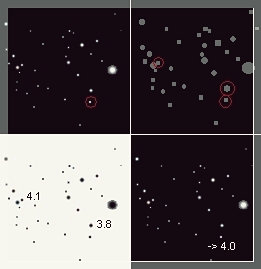
It may be useful to compare magnitudes when performing an observation. Such observation fields like the comets, or the variable need that in any case. An easy way to determine the magnitude of an object resides just in de-focusing your field (be it in binoculars, or any other instrument). The stars then just turn into disks, the comparison in luminosity of which is much easier, just provided that you know the magnitude of the surrounding stars, through an astronomical software, or an atlas! The following diagram is well showing that, as the practice is more obvious still

Let's assume that you want to know what magnitude the circled star is. Just de-focus the field. Stars turning into disks. You check that your star is neatly less in magnitude than the star just above it, and that it's barely more luminous than the star circled at the upper left. With a software or atlas, you'll know that the first one is at the 3.8th magnitude, and the second at the 4.1th. So. You star is neatly less than the 3.8th magnitude, and barely more luminous than 4.1, hinting with a fairly good precision to that it's about the 4th magnitude! Fine!
You will note however that that method is showing some restrictions: it works well mostly with point-like objects (like stars, for example), as more diffuse objects (like nebulae or comets, for example) may or may not be easily estimated through that method. On the other hand, some specific observational fields may require -should you want, for example, join an observing group- an adjustment of that method for more scientific purposes. As far as the observation of variable stars is concerned, such a method is necessary because human retina is not able to compare luminosity between two bright stars. Further, the longer one observes red-coloured stars the more they look luminous, which brings to assess swiftly their brightness
Website Manager: G. Guichard, site 'Amateur Astronomy,' http://stars5.6te.net. Page Editor: G. Guichard. last edited: 12/28/2010. contact us at ggwebsites@outlook.com